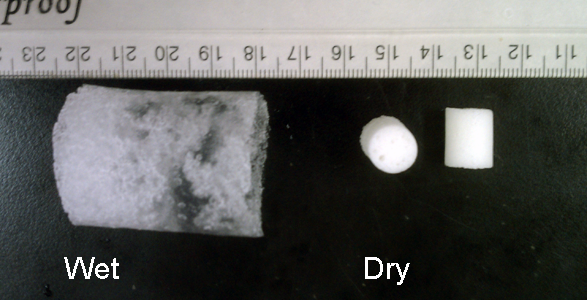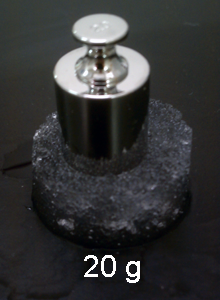Superporous Hydrogels

AQ002 (Aquagel-XS)
Aquagel Superporous Hydrogel –XS (extra-strong)
Product is chemically similar to standard superporous hydrogel, except further modified to have higher strength. Swelling capacity of Aquagel-XS is around 20 to 30 times however, as shown below, this hydrogel has the strength to provide mechanical support even supporting up to 20 grams without moving.


Sample cylinders (~1 cm tall x 1 cm diameter) are available for ordering.
Superporous Hydrogels
Product Information
AQUAGEL™ superporous hydrogels have the following properties:
Fast Responsiveness
Conventional hydrogels swell or shrink in response to environmental changes too slowly for many applications. Our AQUAGEL™ superporous hydrogel technology allows preparation of hydrogel systems that change their dimensions in a matter of a minute, regardless of size.
High Swelling Ratio
AQUAGELs swell not only fast but also to very large sizes. The swelling ratio (swollen size⁄dry size) can be as large as several hundred. To maintain the mechanical strength of fully swollen hydrogels, the swelling ratio can be lowered to less than 100 by increasing the crosslinking density. The enhanced mechanical property can also be obtained by making superporous hydrogel composites and/or elastic superporous hydrogels.
Elasticity
AQUAGELs swell in water in less than a minute regardless of their sizes. Since more than 90% of the weight of swollen superporous hydrogels is water, they are usually mechanically weak. Akina has developed AQUAGEL™ elastic superporous hydrogels that can stretch more than 100% of their original size. The high elasticity also makes the superporous hydrogels mechanically resilient. The elastic superporous hydrogels are ideal for various applications ranging from oral controlled-release formulations to tissue engineering applications.
AQUAGEL™ Samples Available for Purchase
Please note that samples are not intended for clinical usage and are for research purposes only.
Standard Superporous Hydrogel
Samples of standard formulation AQUAGEL™ are available for purchase. Other sizes and shapes can be made. Please contact us for a quotation on superporous hydrogels which match your desired size and shape.
Custom Superporous Hydrogels Available
Superporous hydrogels can also be custom formulated to match your desired application. Prices on custom formulated hydrogels vary and please contact us to discuss your application further. Note that these hydrogels can be varied to match your desired properties by altering their manufacturing method and contents.
AQUAGEL™ Questions and Answers
Is your AQUAGEL™ biocompatible?
The stock AQUAGEL™ we have on hand now is not necessarily designed for a medical usage, however we can generate material that is comprised of highly-porous crosslinked biocompatible polymer, such as poly(acrylic acid) (PAA). PAA has US-FDA Generally Regarded as Safe (GRAS) status, and as such is very biocompatible. There are other GRAS polymers we can use for this as well, which are very biocompatible.
Is it biodegradable? If yes, in which time frame?
Typical superporous hydrogel is not biodegradable over any meaningful timeframe (vinylic polymer), however it can be modified to contain biodegradable crosslinkers which will allow the material to biodegrade as whole. This can be done on a custom synthesis basis. Generally a highly-hydrated material such as this is biodegradable in very short time frames since there is so much water exposure (days-weeks at most).
Is it FDA approved for medical applications?
We have licensed the use of this material for manufacturing hydrophobic coatings on coils that are used to block aneurysms. There are variants of this material that are FDA approved for medical applications, however, for the synthesis of this hydrogel directly, Akina lacks the GMP facilities for generating this in-house.
Not the Aquagel you were looking for? Aquagel is our registered trademark (No. 4,078,874) for rapidly swelling hydrogels for use in the manufacture of pharmaceutical and biomedical preparations.
This site ranks at the top for both Google and Bing organic searches for Aquagel. Contact us if you would like to see your link here.
 Akinalytics
Akinalytics Midwest GMP
Midwest GMP Polymer Blog
Polymer Blog








